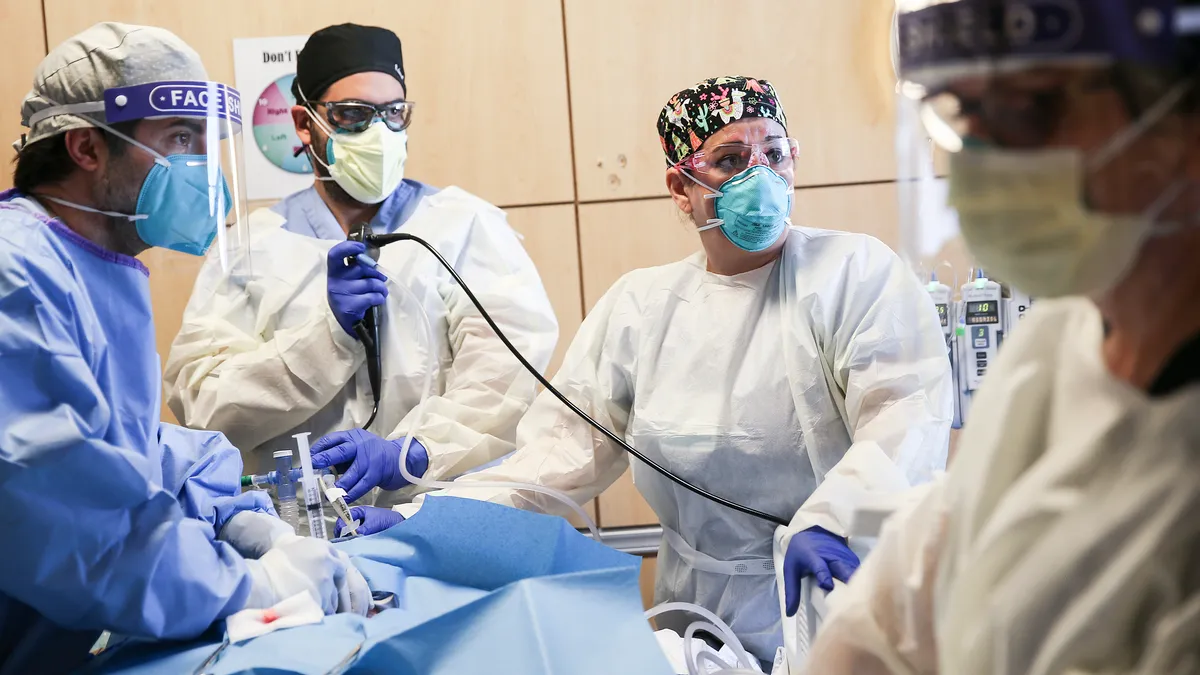Dive Brief:
- Procedure volumes for multiple types of surgery increased in the second quarter and are set to continue rising over the second half of the year, according to a survey of physicians by Stifel analysts.
- Most interventional cardiologists, electrophysiologists and general surgeons reported procedure growth and expect continued improvement later in the year. The analysts see the findings as positive for Abbott Laboratories, Johnson & Johnson and Intuitive Surgical, and supportive of Edwards Lifesciences’ and Medtronic’s transcatheter aortic valve replacement (TAVR) procedure targets.
- Hip and knee surgeons were the only physicians to report flat volumes in the second quarter. Even so, the analysts “feel directionally better” that volumes of devices sold by Stryker and Zimmer Biomet will improve in the second half.
Dive Insight:
Stifel’s survey polled 200 surgeons, split evenly among the four areas, to see if procedure volumes are recovering from the omicron wave that affected the first quarter. The headline findings are positive, and come the week before the medtech industry is set to report earnings.
“Macroeconomic pressures and uncertainties remain over the economy, supply chain, critical component availability, currency, and cost inflation. But this broad-based survey does leave us more encouraged that procedures are recovering, and some healthcare-centric pressures like staffing shortages are being managed,” the analysts wrote.
The electrophysiologists reported 9% procedure growth versus the first three months of the year, and 22 of the 50 physicians said they expect volumes to rise again in the second half of 2022. Four of the electrophysiologists expect volumes to fall.
The analysts interpreted the findings as “directionally positive” for Abbott and J&J, both of which derive around 5% of total sales from their electrophysiology and interventional solutions divisions. Boston Scientific and Medtronic are less reliant on electrophysiology but could still benefit from rising volumes.
In interventional cardiology, 44% of the polled physicians said volumes were “a little better” in the second quarter. All the cardiologists expect “a more meaningful” step up in procedures in the third and fourth quarters.
Zeroing in on the 27 physicians who perform TAVR procedures, the analysts found volumes are expected to rise sequentially every quarter this year.
“The cadence of procedure growth would seem to line up with Medtronic’s and Edwards’ stronger TAVR sales expectations” for the second half, the analysts wrote.
General surgeons provided the most upbeat responses, with 68% of the physicians reporting a second-quarter increase in procedure volumes. Half of those physicians saw volumes rise 10% to 25%. Further gains are forecast for the rest of the year.
The analysts expect J&J, which “should see less competition from a currently supply-chain-weakened [Medtronic],” to benefit from the trends. Three-quarters of users of Intuitive’s da Vinci robots reported increased procedure volumes in the second quarter.
Orthopedic surgeons were the sole exception to the positive second-quarter trends. Based on the survey, volumes were relatively flat in the second quarter, a finding the analysts said was perhaps unsurprising given that hip and knee procedures have historically been slower to recover from COVID-19 waves.
The expectation of a 15% rise in hip and knee procedures in the third quarter encouraged the analysts that Stryker, Zimmer and their peers “could see a better second half.”











